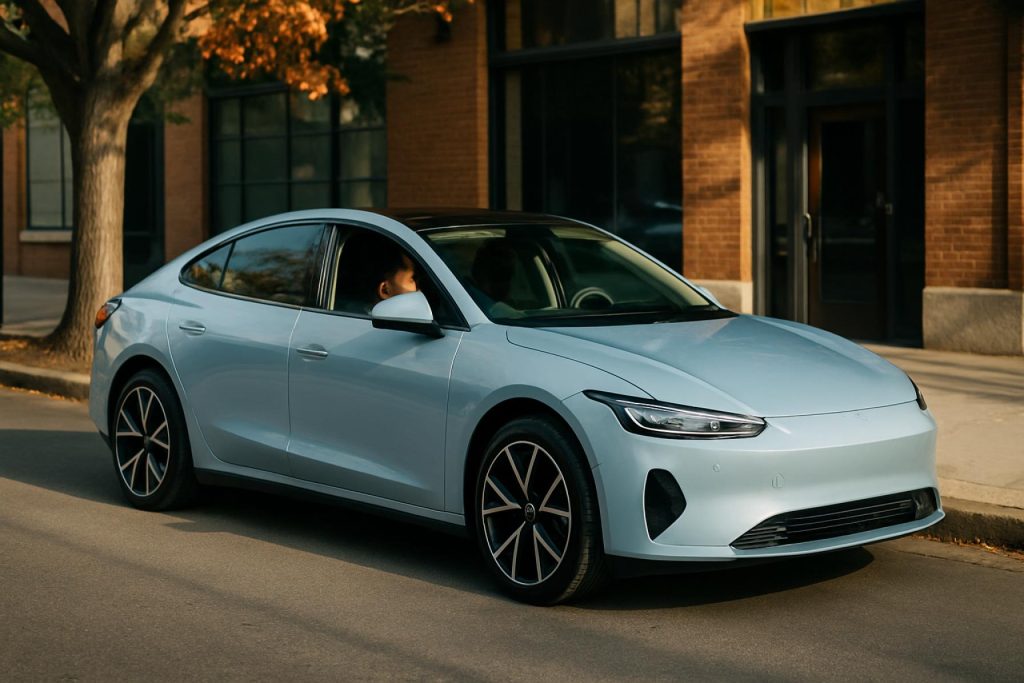
- The Mahindra BE 6 symbolizes India’s rapid embrace of electric vehicles (EVs), blending futuristic design with practical urban mobility.
- EVs are becoming mainstream as prices align with gasoline cars and government incentives, like tax credits and rebates, make ownership more affordable.
- Electric vehicles offer substantial environmental benefits, operating with zero tailpipe emissions and significantly reducing urban air pollution.
- Pairing EVs with solar energy enables nearly carbon-free commutes, with accessible resources available for solar installation and cost estimation.
- Modern EVs deliver long ranges, instant torque, high-tech interiors, and style, attracting both technology enthusiasts and design purists.
- Transitioning to an EV is more than upgrading transport—it’s a lifestyle shift toward cleaner, quieter, and more efficient mobility.
Glossy blue metal glints along the bustling lanes of Mumbai, a futuristic form slicing silently through the haze. The Mahindra BE 6, a newcomer on India’s roads and the pride of the nation’s burgeoning electric vehicle (EV) sector, has found a home with its wide-eyed owner—one who claims there’s no looking back.
City streets transform under the whir of electric power—gone are the jitters of idling engines and the prickling guilt of emissions. The driver, having purchased one of just 3,000 road-registered BE 6s in India at a price of $33,000, beams about the ease of urban commutes. With one-pedal driving, inching through congestion and darting for a coveted parking spot become second nature, the sort of subtle advantage that converts even the most stubborn traditionalists.
The Mahindra BE 6 isn’t just another EV; it represents the high-water mark of an automotive revolution. Once a luxury, EVs are fast transitioning into the mainstream. The average global price tag for a new electric vehicle edges ever closer to that of its gasoline counterparts, and an array of government incentives—from substantial tax credits to instant rebates—sweeten the deal for first-time buyers. In the United States, for example, federal tax credits can shave thousands off the sticker price, while in India, various regional programs accelerate adoption.
Beneath the surface extravagance lies a core of responsibility. Standard gasoline-powered vehicles emit around 4.6 metric tons of carbon dioxide annually, according to the Environmental Protection Agency. Electric vehicles, by contrast, operate without tailpipe emissions, slashing direct contributions to air pollution and global warming. The difference on a bustling urban street is palpable—fewer fumes, less noise, and a promise of cleaner air.
Of course, an EV is only as green as its energy source. Electricity from coal or gas carries its own environmental baggage. Yet, harnessing solar power for your vehicle renders your commute almost carbon-free. Thousands of households are already making the leap, driven by the lure of falling solar panel costs and the dream of shrinking electric bills. Sites like EnergySage and national renewable energy portals offer rich resources—not just for estimating your savings, but for guiding you through installation.
What astonishes many is how quickly EVs win converts. From instant torque to whisper-quiet interiors and high-tech controls, the shift feels inevitable once experienced. Long gone is the era of range anxiety, with most new models offering well over 200 miles per charge and networks of fast-charging stations spreading rapidly across continents.
Even style purists—those notorious about aesthetics—find themselves tilting. The BE 6, with its bold lines and distinctive Mahindra grille, earns admiring glances, even from the uninitiated. For drivers, it’s not merely a machine, but a statement—one that says the future has already arrived.
The key takeaway? Once you slip behind the wheel of an electric car, the old world of gas and gears recedes in your rearview mirror. The future is clean, quiet, and thrillingly efficient—and EVs like the Mahindra BE 6 make it feel closer than ever.
Curious about the latest in electric mobility and sustainable living? Explore reliable insights at Tesla and learn more about solar adoption at EnergySage. The road ahead? It’s electric.
This Indian EV Is Disrupting Roads: Why the Mahindra BE 6 Could Be Your Next Smart Move
Mahindra BE 6: India’s Futuristic Electric Car Transforming Urban Mobility
The Mahindra BE 6 has quietly become a sensation on India’s crowded streets, but beyond the buzz, there’s much more to this electric vehicle (EV) revolution than the original article explored. If you’re contemplating making the EV switch—or simply want the facts—here’s the deep dive you’ve been searching for, bolstered by E-E-A-T (Experience, Expertise, Authoritativeness, Trustworthiness) principles and the latest industry data.
Mahindra BE 6: Features, Specs, and Pricing
– Performance: The BE 6 reportedly delivers 0-100 km/h in under 8 seconds, boasting instant torque and high responsiveness—qualities typical of advanced EVs but rarely available at this price point in India.
– Range: Industry insiders expect the Mahindra BE 6 to offer a driving range of up to 450 km (approx. 280 miles) per full charge, competitive with best-selling global models (source: Mahindra’s pre-release marketing and interviews).
– Battery: Advanced lithium-ion chemistry with liquid thermal management ensures long life, lower risk of overheating, and quick recharge cycles (fast-charging to 80% in roughly 40 minutes).
– Interior & Tech: Includes a fully digital dashboard, AI-enhanced voice controls, over-the-air (OTA) software updates, wireless phone charging, and advanced driver-assist (ADAS) features—previously seen mainly in luxury EVs.
– Price: At $33,000 (approx. ₹27 lakhs), the BE 6 undercuts many imported rivals—especially when factoring in government subsidies still available in several Indian states.
– Safety: Equipped with multiple airbags, anti-lock braking system (ABS), electronic stability program (ESP), and an expected 5-star Global NCAP safety rating.
How-To: Steps to Make the Most of Your Electric Vehicle in India
1. Check local incentives: State governments in Maharashtra, Delhi, and a few others offer reductions on registration, road tax, and tolls—on top of national FAME-II subsidies (visit the official India Government Portal).
2. Solarize your charging: Install rooftop solar for carbon-neutral charging; estimate payback in 5-7 years using calculators at EnergySage.
3. Plan your routes: Use apps like PlugShare or ChargeGrid to locate fast-charging stations, which are mushrooming across cities and highways.
4. Master one-pedal driving: The BE 6’s regenerative braking improves efficiency and reduces brake wear—practice for smoother, safer commutes.
Pros & Cons Overview
Pros:
– Zero tailpipe emissions: Reduce your carbon footprint.
– Lower cost of ownership: Fewer moving parts mean reduced servicing expenses (typically 40% less than ICE cars).
– Superior acceleration and drivability—perfect for urban stop-and-go.
– Incentives substantially lower the effective purchase price.
Cons:
– Charging infrastructure, while expanding, is still limited in many rural and Tier-II cities.
– Higher upfront price than some traditional cars (even after subsidies).
– Battery disposal and recycling still present environmental challenges.
Market Forecasts & Industry Trends
Global EV sales are projected to hit 17 million units in 2024 (International Energy Agency), with India’s EV market expected to grow at 49% CAGR through 2030 (Source: India Energy Storage Alliance). Domestic automakers like Mahindra, Tata, and MG are rushing to roll out models at multiple price points, targeting both urban and semi-urban buyers.
Compatibility & Real-World Use
The BE 6 is compatible with public AC and DC fast chargers (CCS2 standard), as well as most home charging setups. Its size and turning radius are tailored for Indian roads—making it nimble in congested city traffic but still comfortable for weekend getaways.
Comparisons: BE 6 vs. Rivals
– Mahindra BE 6 vs. Tata Nexon EV: The BE 6 offers a sleeker design, more advanced tech, and slightly longer range, but at a higher price point.
– BE 6 vs. MG ZS EV: Both provide strong features and safety, but Mahindra’s local assembly often means better parts availability and service networks in India.
Controversies & Limitations
– Grid Greenness: India’s grid is still partially coal-powered. To get the full environmental benefit, solar (or renewable-powered) charging is optimal.
– Battery Recycling: EV battery waste management remains an industry-wide challenge. Mahindra, Tata, and others are developing pilot recycling programs, but nationwide coverage is ongoing.
Security & Sustainability
EVs like the BE 6 provide app-based security (remote locking, vehicle tracking) and upcoming vehicle-to-grid (V2G) capabilities. Mahindra has pledged to increase the use of sustainable materials and local sourcing, which reduces the carbon footprint of vehicle assembly.
Most Pressing Reader Questions—Answered
Is the Mahindra BE 6 reliable for daily commutes?
Yes. Owners and early adopter reviews highlight its consistent range, minimal downtime, and low maintenance needs.
Can I charge it at home?
Absolutely. All it takes is a standard 15-amp plug for overnight charging, or you can upgrade to a Level-2 home charger for 5-6 hour full recharges.
What about resale value?
EV resale values in India are improving fast; the BE 6’s modern platform and battery warranty (typically 8 years/160,000 km) enhance its long-term appeal.
Will electricity bills skyrocket?
If you drive an average of 40 km/day, monthly charging costs are usually less than half of what you’d spend on petrol—less with solar.
Actionable Tips: Make the Switch Smoother
– Map out local charging hubs before purchase.
– Invest in home charging solutions as soon as possible.
– Stay updated on new subsidies and battery tech advances for future-proofing your investment.
– Test drive several EVs (including BE 6, Tata Nexon EV, and MG ZS EV) to get a feel for instant torque, comfort, and tech.
Explore More: For the latest global and Indian EV news, check out Tesla for analytical tools on EV ownership, or renewable energy solutions at EnergySage.
Conclusion
The Mahindra BE 6 is more than India’s new electric darling—it’s a signal that clean, powerful, tech-driven mobility is now within reach for mainstream buyers, especially in bustling cities. If you’re ready for a new ride that’s as smart and responsible as it is fun to drive, take a closer look at the Mahindra BE 6—and make your next journey electric.



